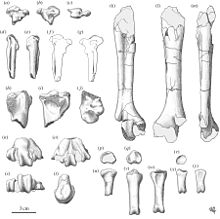Garganornis ballmanni
| Garganornis ballmanni | ||||||||||||
|---|---|---|---|---|---|---|---|---|---|---|---|---|

Garganornis ballmanni in a living reconstruction by Stefano Maugeri. |
||||||||||||
| Temporal occurrence | ||||||||||||
| Miocene | ||||||||||||
| 9 to 5.5 million years | ||||||||||||
| Locations | ||||||||||||
| Systematics | ||||||||||||
|
||||||||||||
| Scientific name of the genus | ||||||||||||
| Gargan Ornis | ||||||||||||
| HJM Meijer, 2014 | ||||||||||||
| Scientific name of the species | ||||||||||||
| Garganornis ballmanni | ||||||||||||
| HJM Meijer , 2014 | ||||||||||||
Garganornis ballmanni is a fossil bird species from the order of the geese , the only locations of which are so far limited to the eponymous mountain region Gargano in Apulia on the Italian east coast and Scontrone in Abruzzo . So far, only this one species has been describedin the genus Garganornis .
discovery
Garganornis was chosen as the generic name because the holotype was found in the area around Gargano. Ornis comes from the Greek word for bird . Peter Ballmann , who researched the fossil avifauna in the Gargano region, was named after the species .
For the first time, remains of Garganornis bellmanni were found near Apricena in Gargano . An age determination showed that the animal had lived in the Miocene almost 6 to 5.5 million years ago. The holotype was first described by Meijer in 2014 using a left tibiotarsus (RGM 443307). In 2016 Gargano found several carpometacarpi (DSTF-GA 49, NMA 504/1801), tarsometatarsi (RGM 425554, RGM 425943), a tibiotarsus (DSTF-GA 77) and several finger bones of the foot (MGPT-PU 135356, RGM 261535, RGM 261945) by Pavia et al. described. At the same time, other, geologically older, but morphologically comparable finds around 9 million years old were discovered in Scontrone. These include an almost complete tarsometatarsus (SCT 23).
features
Garganornis was unusually large for a geese bird, in an upright position it was about 1.5 m tall with a body weight of an estimated 15-22 kg. This calculation is based on the dimensions of the tibiotarsus , which is about a third larger than that of the mute swan still alive today. It is believed that the bird was most likely flightless. This is corroborated by the findings of the fossil carpometacarpi of the wings. These are shorter and more robust than comparable bones of living geeseed birds, also noticeably flattened at the top. The trochlea carpalis was rather thin and regressed, which restricted joint mobility and also fits the theory of a flightless lifestyle. Some specimens of Garganornis ballmanni have a round ossification on the Carpometacarpus, which is also known in birds still alive today and is used in fights, for example for territories.
Classification
On the basis of morphological features, Garganornis can be precisely classified in the order of geese birds. On the tibiotarsus, the medial tibial condyle is angled towards the middle and elongated towards the front, and the extensor tendon canal runs centrally over the intercondylar fossa . Subsequently, a further assignment to the duck birds can take place within the order based on the special configuration of the carpometacarpus. Here the processus extensorum runs parallel to the trochlea carpalis and does not extend towards the floor, the processus pisiformis is broad and rounded, in addition there is a round ossification on the caudal fovea carpalis.
Individual evidence
- ↑ a b c d H.JM Meijer: A peculiar anseriform (Aves: Anseriformes) from the Miocene of Gargano (Italy) . Ed .: Comptes Rendus Palevol. tape 13 , no. 1 , 2014, p. 19-26 , doi : 10.1016 / j.crpv.2013.08.001 ( sciencedirect.com ).
- ↑ a b M. Pavia: The extreme insular adaptation of Garganornis ballmanni Meijer, 2014: a giant Anseriformes of the Neogene of the Mediterranean Basin . Ed .: Royal Society Open Science. 2017, doi : 10.1098 / rsos.160722 ( royalsocietypublishing.org ).

